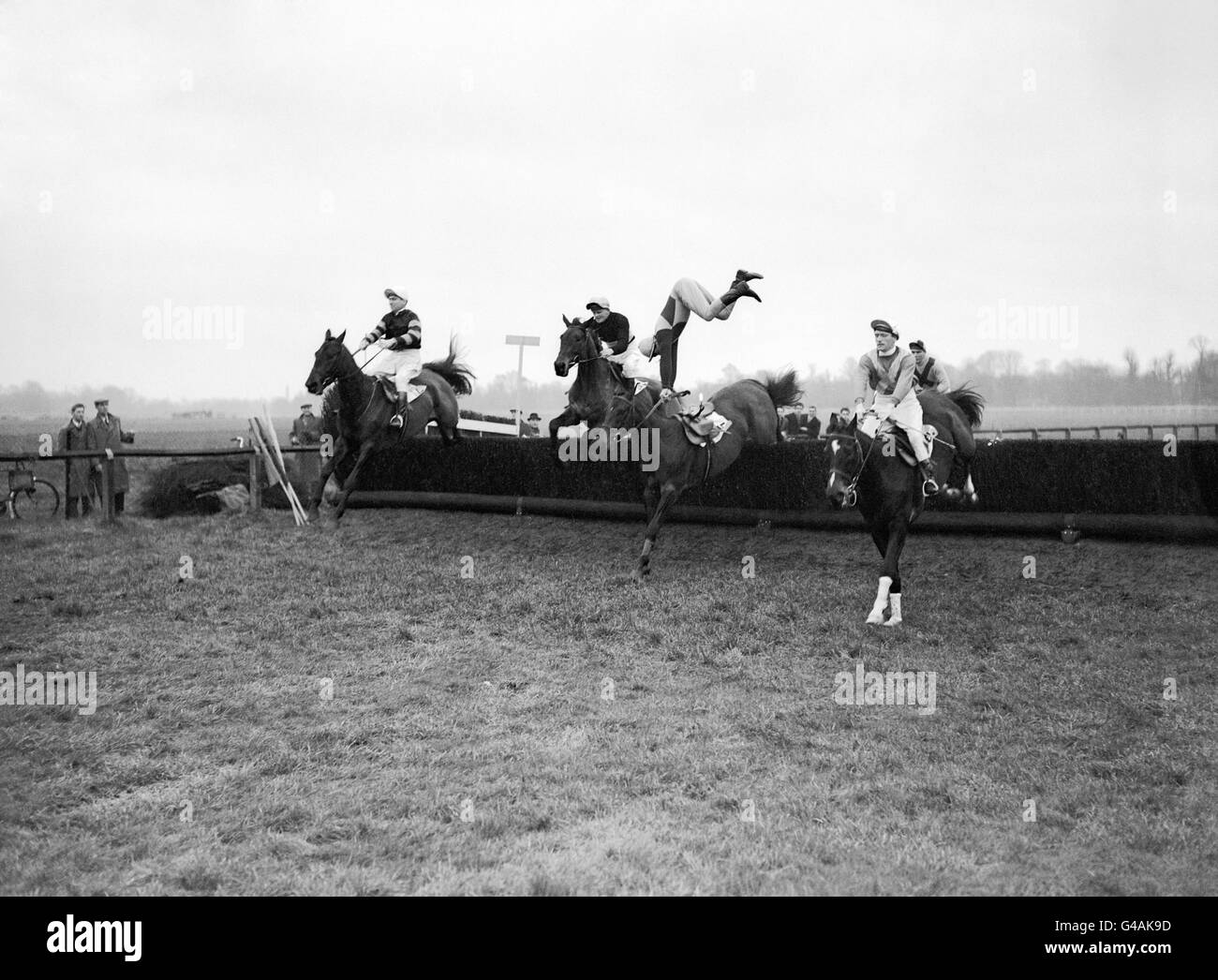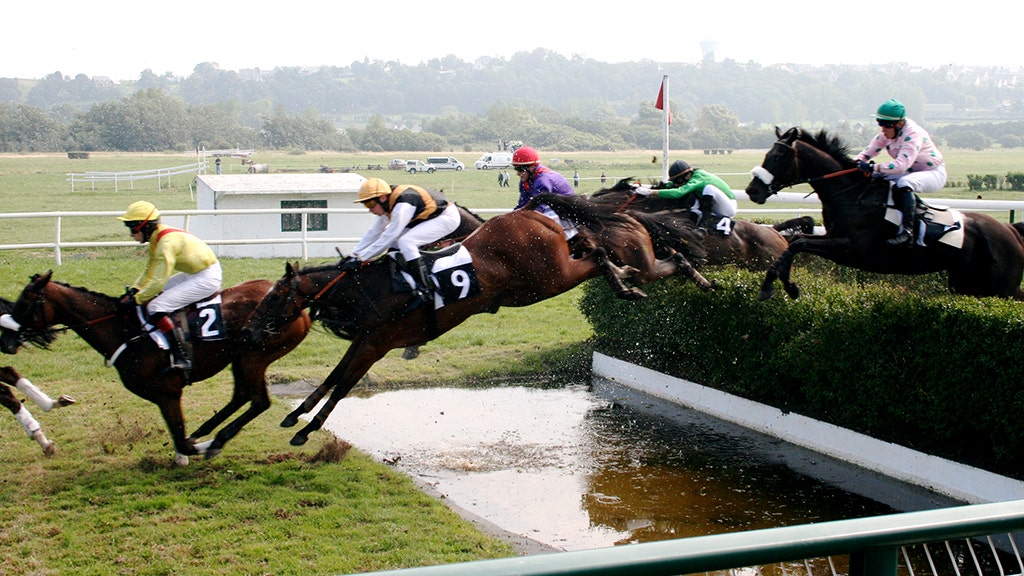Steeplechase Fall Dynamics

Steeplechase racing, a thrilling and demanding discipline, involves a unique set of challenges that increase the risk of falls. The combination of high speeds, obstacles, and the inherent unpredictability of the race makes falls a common occurrence. Understanding the dynamics of steeplechase falls is crucial for athletes, coaches, and spectators alike, as it provides insights into the underlying mechanisms and potential injury risks.
Types of Steeplechase Falls
Falls in steeplechase races can occur at various points throughout the course. Here are some common types of falls:
- Falls over hurdles: Hurdles, with their height and spacing, pose a significant obstacle for steeplechase runners. A mistimed approach or a loss of balance can lead to a fall over the hurdle. These falls can be particularly dangerous, as the athlete’s momentum carries them forward and they may land on their back or head.
- Falls over water jumps: The water jump, a signature element of steeplechase racing, presents its own set of challenges. Runners must navigate a steep incline followed by a descent into the water, then an immediate ascent back onto the track. A stumble or loss of momentum during this sequence can result in a fall.
- Falls on the track: Falls can also occur on the track itself, often due to fatigue, loss of balance, or collisions with other runners. The high speeds and close proximity of competitors increase the risk of falls on the track.
Biomechanics of a Steeplechase Fall
The biomechanics of a steeplechase fall involve a complex interplay of forces and movements. Here are some key factors:
- Impact forces: Falls often involve significant impact forces, especially when the athlete falls over a hurdle or water jump. These forces can be substantial, potentially leading to bone fractures or soft tissue injuries.
- Rotational forces: Falls can also generate rotational forces, particularly when the athlete lands on their side or back. These forces can strain ligaments and tendons, potentially leading to sprains or tears.
- Ground reaction forces: The ground reaction forces experienced during a fall can be significant, especially when the athlete lands on a hard surface. These forces can contribute to muscle strains, ligament tears, and other injuries.
Factors Influencing Steeplechase Falls
Several factors can influence the likelihood of a steeplechase fall:
- Speed: Higher speeds increase the momentum of the runner, making it more difficult to control their body and recover from a stumble.
- Fatigue: Fatigue can impair coordination and balance, increasing the risk of falls.
- Terrain: The uneven terrain of the steeplechase course, including the hurdles and water jump, can create challenges for runners, increasing the risk of falls.
- Weather conditions: Slippery surfaces, such as rain or snow, can increase the risk of falls.
- Obstacle design: The height, spacing, and design of hurdles can influence the risk of falls.
- Runner technique: Proper technique is crucial for avoiding falls. A strong foundation in steeplechase technique, including hurdle clearance, water jump execution, and pacing, can significantly reduce the risk of falls.
Causes and Contributing Factors

Steeplechase falls are a serious concern in the sport, posing risks to both horse and rider. Understanding the contributing factors is crucial for improving safety and minimizing the occurrence of these incidents.
Rider Error
Rider error is a significant contributor to falls in steeplechase racing. Inexperience, poor judgment, and inadequate riding skills can all lead to mistakes that result in a fall.
- Lack of Experience: Riders new to steeplechase racing may be unfamiliar with the challenges of navigating fences and the unique demands of the course. This lack of experience can lead to misjudging jumps, losing control, or failing to anticipate obstacles.
- Poor Judgment: Riders who make poor decisions, such as taking unnecessary risks or attempting jumps they are not prepared for, increase their chances of falling. This can include misjudging the pace, choosing inappropriate lines, or failing to adapt to changing conditions.
- Inadequate Riding Skills: Riders must possess strong equestrian skills, including balance, coordination, and the ability to control the horse effectively. Inadequate riding skills can lead to a loss of control, especially during challenging maneuvers like jumps and turns.
Horse Error
While rider error is often the primary cause of falls, horses can also contribute to accidents. Factors such as lack of experience, temperament, and physical limitations can increase the likelihood of a fall.
- Lack of Experience: Horses new to steeplechase racing may be unfamiliar with the course, the fences, and the demands of the race. This lack of experience can lead to hesitancy, refusals, or misjudging jumps, resulting in falls.
- Temperament: Horses with temperamental or unpredictable personalities may be more prone to spooking, refusing jumps, or acting out in ways that lead to falls. This can be exacerbated by the pressure and excitement of the race.
- Physical Limitations: Horses with physical limitations, such as injuries or health conditions, may not be able to perform at the level required for steeplechase racing. This can lead to fatigue, decreased agility, or an inability to clear fences, increasing the risk of falls.
External Factors
External factors beyond the control of the rider or horse can also play a role in steeplechase falls.
- Course Design: The design of the course, including the placement and height of fences, the layout of turns, and the condition of the ground, can all influence the likelihood of falls. Inadequate design, poorly maintained fences, or challenging terrain can increase the risk of accidents.
- Weather Conditions: Weather conditions, such as rain, wind, or extreme temperatures, can affect the footing, visibility, and horse’s performance. Slippery ground, strong winds, or extreme heat can lead to falls.
- Equipment: The quality and condition of the horse’s tack, including the saddle, bridle, and stirrups, can impact rider safety. Faulty equipment can lead to malfunctions, causing the rider to lose control or fall.
Consequences and Prevention: Steeplechase Fall

Steeplechase falls, while infrequent, can have severe consequences for both riders and horses. Understanding the potential dangers and implementing preventive measures is crucial for ensuring the safety of all involved in this exhilarating sport.
Consequences of Steeplechase Falls
Falls in steeplechase racing can result in a range of injuries, from minor abrasions to life-threatening trauma. Riders are particularly vulnerable to head injuries, spinal cord injuries, and fractures due to the high speeds and challenging obstacles. Horses, too, are susceptible to injuries such as broken legs, ligament tears, and concussions. In some instances, falls can unfortunately lead to fatalities for both riders and horses.
Strategies for Preventing Falls in Steeplechase Racing, Steeplechase fall
Preventing falls in steeplechase racing requires a multifaceted approach that encompasses rider training, horse preparation, and course safety measures.
Rider Training
- Thorough Equestrian Skills: Riders must possess exceptional equestrian skills, including balance, control, and the ability to handle challenging situations.
- Specific Steeplechase Training: Specialized steeplechase training programs focus on navigating obstacles, handling jumps, and developing the rider’s ability to maintain control in challenging conditions.
- Fitness and Strength: Riders need to be physically fit and strong to withstand the demands of steeplechase racing, including the impact of falls.
Horse Preparation
- Physical Conditioning: Horses require rigorous training to build strength, stamina, and agility. This involves regular exercise, including jumping practice, to prepare them for the demands of steeplechase racing.
- Veterinary Care: Regular veterinary checkups, including pre-race examinations, are essential to ensure the horse’s health and fitness.
- Appropriate Equipment: Horses need to be equipped with the right gear, including saddles, bridles, and boots, to ensure their safety and comfort during racing.
Course Safety Measures
- Obstacle Design: The design and construction of obstacles are crucial to minimize the risk of falls. Obstacles should be built with safety in mind, using materials that are durable and provide adequate cushioning.
- Course Maintenance: Regular maintenance of the course, including the repair of fences and the removal of debris, is essential to ensure the safety of both horses and riders.
- Emergency Response: Having a well-equipped and trained emergency response team on site is crucial for handling accidents and providing prompt medical attention to injured riders and horses.
Safety Measures in Different Steeplechase Organizations
| Organization | Safety Measures |
|—|—|
| National Steeplechase Association (NSA) | – Mandatory rider safety equipment (helmets, body protectors) – Strict horse inspection protocols – Course safety regulations – Emergency medical personnel on site |
| Irish National Hunt Steeplechase | – Mandatory rider safety equipment – Strict horse welfare standards – Course safety inspections – Emergency medical services available |
| The Jockey Club (UK) | – Mandatory rider safety equipment – Horse welfare protocols – Course safety regulations – Emergency medical response team |
| Australian Racing Board | – Mandatory rider safety equipment – Strict horse welfare standards – Course safety inspections – Emergency medical services available |
A steeplechase fall can be a dramatic event, with horses and riders tumbling to the ground in a flurry of motion. The danger of such falls was famously captured in the work of kenneth rooks , a filmmaker known for his gritty and realistic portrayal of equestrian sports.
Rooks’ films often showed the raw power and unpredictable nature of these races, reminding viewers of the inherent risks involved in this thrilling spectacle.
A steeplechase fall can be a brutal reminder of the sport’s inherent danger. While the event is known for its grueling nature, the water jumps present an additional challenge, with the potential for a misstep leading to a painful tumble.
The history of the ethiopia steeplechase is filled with athletes who have overcome falls to achieve greatness, demonstrating the resilience and determination required to excel in this demanding discipline. Ultimately, the risk of a steeplechase fall is a constant factor, but it’s also a testament to the courage and skill of the athletes who dare to compete.